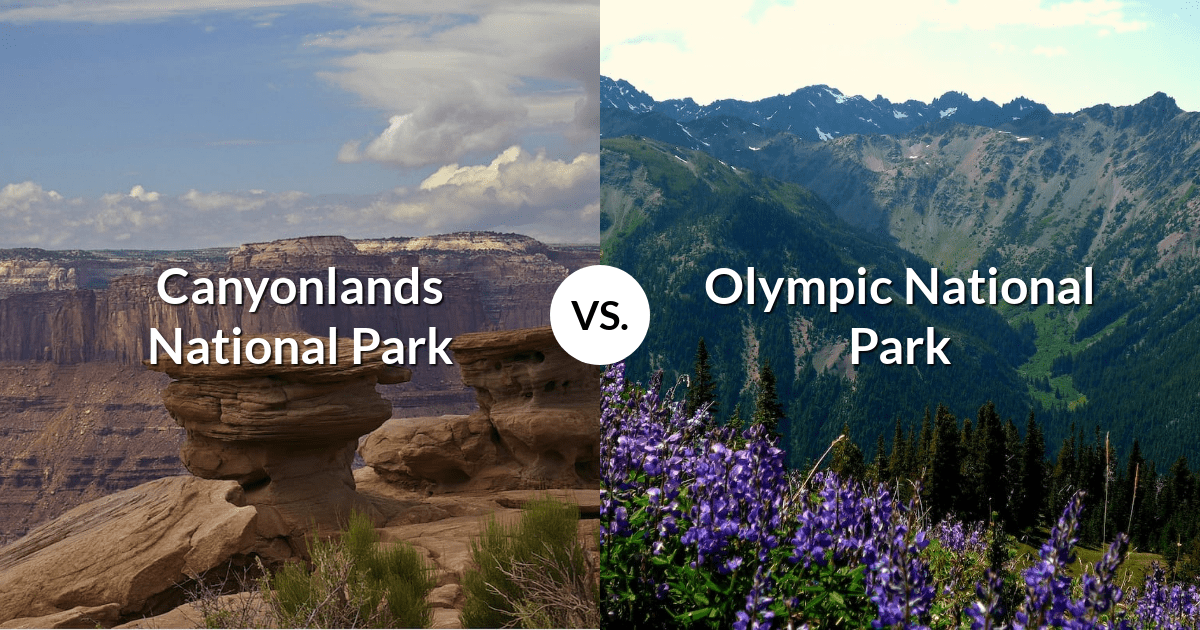Jake Cain is an entrepreneur and writer from Cincinnati, Ohio. He spends his free time driving around the country in his late 90’s conversion van, affectionately known as the “Monster Van” with his wife and 3 boys.
Canyonlands National Park and Olympic National Park are two iconic destinations in the American West and Pacific Northwest, respectively. Both parks offer unique natural beauty and diverse landscapes, from the towering mesas of Canyonlands to the lush rainforests of Olympic. But how do these two parks compare when it comes to family-friendly activities, wildlife, and seasonal weather? In this article, we’ll take a closer look at Canyonlands and Olympic, and explore what makes each park special. Whether you’re planning a family vacation or a solo adventure, you won’t want to miss this exciting comparison of two of America’s most beloved national parks.
Hiking Trails in Canyonlands National Park and Olympic National Park
Canyonlands National Park and Olympic National Park both offer unique and challenging hiking experiences for visitors. Canyonlands is located in southeastern Utah and is known for its vast canyons, mesas and buttes, while Olympic is located in Washington State and is known for its lush rainforest and rugged coastline.
In Canyonlands, some of the easiest hikes include the Mesa Arch Trail, which is only 0.5 miles long and offers stunning views of the surrounding canyons, and the Cave Spring Trail, which is a 1-mile loop that takes visitors to an historic cowboy camp. On the other hand, the hardest hike at Canyonlands is the 100-mile long Hayduke Trail, which passes through some of the harshest terrain in the park and requires advanced backcountry skills.
In Olympic, some of the easiest hikes include the Hurricane Ridge Trail, which offers panoramic views of the Olympic Mountains, and the Hoh Rainforest Trail, which takes visitors through one of the largest temperate rainforests in the United States. The hardest hike in Olympic is the 93-mile long Pacific Crest Trail, which passes through the park and requires extensive backpacking experience.
Overall, both Canyonlands and Olympic National Parks offer a wide range of hiking experiences, from easy and scenic walks to challenging backcountry adventures. Whether you’re a seasoned hiker or just starting out, these parks have something for everyone.
Most Popular Hiking Trails in Canyonlands National Park
| Name | Length | Elevation | Type | Difficulty | Visitor Ratings |
|---|---|---|---|---|---|
| Mesa Arch Trail | 965.604 | 18.8976 | Easy | loop | 4.5 |
| Grand View Point Trail | 2896.812 | 52.7304 | Easy | out and back | 4.5 |
| Chesler Park Loop Trail | 18668.344 | 589.788 | Moderate | loop | 5 |
| False Kiva Trail | 3057.746 | 136.8552 | Moderate | out and back | 4.5 |
| Upheaval Dome via Crater View Trail | 2414.01 | 91.7448 | Moderate | out and back | 4 |
| Aztec Butte Trail | 2092.142 | 66.7512 | Moderate | out and back | 4.5 |
| Druid Arch Trail | 15288.73 | 418.7952 | Moderate | out and back | 4.5 |
| Shafer Trail | 30899.328 | 949.7568 | Moderate | point to point | 4.5 |
| White Rim Overlook Trail | 2896.812 | 48.768 | Easy | out and back | 4.5 |
| Syncline Loop | 13840.324 | 496.824 | Very Hard | loop | 4.5 |
Most Popular Hiking Trails in Olympic National Park
| Name | Length | Elevation | Type | Difficulty | Visitor Ratings |
|---|---|---|---|---|---|
| Hurricane Hill via Hurricane Ridge | 4988.954 | 242.9256 | Moderate | out and back | 4.5 |
| Mount Storm King | 6276.426 | 638.8608 | Hard | out and back | 5 |
| Sol Duc Falls Nature Trail | 2574.944 | 77.724 | Easy | out and back | 4.5 |
| Hoh Rain Forest Hall of Moss | 1609.34 | 23.7744 | Easy | loop | 4.5 |
| Marymere Falls Trail | 2735.878 | 90.8304 | Easy | out and back | 4.5 |
| Hoh River Trail | 52786.352 | 1558.7472 | Moderate | out and back | 4.5 |
| High Divide – Seven Lakes Basin Loop | 30577.46 | 1617.8784 | Hard | loop | 5 |
| Ruby Beach | 2253.076 | 20.7264 | Easy | loop | 4.5 |
| Staircase Rapids Loop | 3379.614 | 64.9224 | Easy | loop | 4.5 |
| Spruce Railroad Trail: Lake Crescent | 18024.608 | 131.9784 | Easy | out and back | 4.5 |
Wildlife in Canyonlands National Park and Olympic National Park
Canyonlands National Park and Olympic National Park are both home to a diverse array of wildlife, including unique species of animals, birds, and plants. However, the types of wildlife that can be seen at each park are quite different due to the distinct ecosystems found in each location.
In Canyonlands, visitors can expect to see a variety of desert animals, such as rattlesnakes, coyotes, and pronghorns. The park is also home to a variety of bird species, including hawks, eagles, and ravens. In addition, the park’s arid landscape is home to a variety of unique plant species, such as cacti, yucca, and sagebrush.
In Olympic, visitors can expect to see a variety of forest animals, such as black bears, elk, and cougars. The park is also home to a variety of bird species, including eagles, owls, and woodpeckers. In addition, the park’s lush rainforest is home to a variety of unique plant species, such as ferns, mosses, and giant conifers.
Overall, both Canyonlands and Olympic National Parks offer visitors the chance to see a wide range of wildlife, each with its own unique characteristics and adaptations. Whether you’re interested in desert animals or forest creatures, these parks have something for everyone.
Below are lists of the most commonly spotted wildlife at Canyonlands National Park and Olympic National Park. However, you can see a full list of wildlife at each national park here.
Birds
| Canyonlands National Park | Olympic National Park |
|---|---|
| Peregrine Falcon | Peregrine Falcon |
| Northern Harrier | Northern Harrier |
| Sharp-Shinned Hawk | Sharp-Shinned Hawk |
| Osprey | Osprey |
| Tree Swallow | Tree Swallow |
| Mallard | Mallard |
| Canada Goose | Canada Goose |
| Lincoln’s Sparrow | Lincoln’s Sparrow |
| Ruby-Crowned Kinglet | Ruby-Crowned Kinglet |
| American Robin | American Robin |
| Great Horned Owl | Great Horned Owl |
| Red-Tailed Hawk | Red-Tailed Hawk |
| Northern Flicker | Northern Flicker |
| Merlin | Barn Swallow |
| Barn Swallow | Savannah Sparrow |
| Savannah Sparrow | Great Blue Heron |
| Great Blue Heron | Hermit Thrush |
| Hermit Thrush | American Kestrel |
| American Kestrel | Bald Eagle |
| Bald Eagle | Song Sparrow |
| Song Sparrow | European Starling |
| European Starling | Northern Pintail |
| Northern Pintail | American Wigeon |
| American Wigeon | Green-Winged Teal |
| Green-Winged Teal | American Pipit |
Mammals
| Canyonlands National Park | Olympic National Park |
|---|---|
| Coyote | Coyote |
| American Beaver | American Beaver |
| Muskrat | Muskrat |
| Big Brown Bat | Big Brown Bat |
| Bobcat | Striped Skunk |
| Striped Skunk | Little Brown Bat |
| Little Brown Bat | Deer Mouse |
| Deer Mouse | Raccoon |
| Raccoon | Black Bear |
| Black Bear | Porcupine |
| Porcupine | Silver-Haired Bat |
| Silver-Haired Bat | Red Fox |
| Hoary Bat | Long-Tailed Weasel |
| Red Fox | House Mouse |
| Long-Tailed Weasel | Wolf |
| House Mouse | Long-Legged Myotis |
| Mountain Lion | Long-Eared Myotis |
| American Mink | California Myotis |
| Mule Deer | Snowshoe Rabbit |
| Common Gray Fox | North American River Otter |
| Long-Legged Myotis | Fringe-Tailed Myotis |
| Long-Eared Myotis | Masked Shrew |
| American Badger | Water Shrew |
| Ermine | Western Big-Eared Bat |
| California Myotis | Bushy-Tailed Woodrat |
Fish
| Canyonlands National Park | Olympic National Park |
|---|---|
| Rainbow Trout | Steelhead/Rainbow Trout |
| Brown Trout | Brook Trout |
| Largemouth Bass | Largemouth Bass |
| Green Sunfish | Salish Sucker |
| Bluegill | Coho Salmon |
| Fathead Minnow | Chinook Salmon |
| Common Carp | Longnose Dace |
| Northern Pike | Speckled Dace |
| Speckled Dace | Threespine Stickleback |
| Yellow Bullhead | Sockeye Salmon |
| Channel Catfish | Pink Salmon |
| Kokanee Salmon | Chum Salmon |
| Black Crappie | Dolly Varden |
| Black Bullhead | Cutthroat Trout |
| Mosquitofish | |
| Smallmouth Bass |
Reptiles
| Canyonlands National Park | Olympic National Park |
|---|---|
| Gophersnake | Western Terrestrial Garter Snake |
| Terrestrial Gartersnake | Common Garter Snake |
| Eastern Racer | Rubber Boa |
| Prairie Rattlesnake | Western Fence Lizard |
| Common Sagebrush Lizard | |
| Greater Short-Horned Lizard | |
| Side-Blotched Lizard | |
| Common Kingsnake | |
| Nightsnake | |
| Long-Nosed Leopard Lizard | |
| Striped Whipsnake | |
| Smith’s Black-Headed Snake | |
| Tree Lizard | |
| Western Whiptail | |
| Eastern Collared Lizard | |
| Desert Spiny Lizard |
Amphibians
| Canyonlands National Park | Olympic National Park |
|---|---|
| Northern Leopard Frog | Bullfrog |
| Tiger Salamander | |
| American Bullfrog | |
| Woodhouse’s Toad | |
| Red-Spotted Toad | |
| Canyon Treefrog |
Insects
| Canyonlands National Park | Olympic National Park |
|---|---|
| Honey Bee |
Beautiful Landscapes in Canyonlands National Park and Olympic National Park
Canyonlands National Park and Olympic National Park are both renowned for their diverse and breathtaking landscapes. Both parks offer visitors a chance to see some of the most beautiful and awe-inspiring natural wonders in the United States.
In Canyonlands, the most famous landscapes include the vast canyons, mesas, and buttes that make up the park’s unique terrain. Visitors can also see scenic overlooks, such as the Grand View Point and the Island in the Sky, which offer panoramic views of the surrounding landscape. In addition, the park is home to a variety of unique rock formations, such as the Needles, which are towering spires of sandstone.
In Olympic, the most famous landscapes include the rugged coastline, lush rainforest, and snow-capped Olympic Mountains. Visitors can see waterfalls, such as the Sol Duc Falls and the Marymere Falls, as well as scenic overlooks, such as the Hurricane Ridge and the Hoh Rainforest. In addition, the park is home to a variety of unique plant life, such as the old-growth trees and lush undergrowth that make up the Hoh Rainforest.
Overall, both Canyonlands and Olympic National Parks offer visitors a chance to see some of the most beautiful and awe-inspiring landscapes in the United States. Whether you’re interested in vast canyons, rugged coastlines, or lush rainforests, these parks have something for everyone.
Things To-Do and Activities in Canyonlands National Park and Olympic National Park
Canyonlands National Park and Olympic National Park both offer a wide range of outdoor activities for visitors to enjoy. Both parks are popular destinations for outdoor enthusiasts, offering unique experiences and breathtaking scenery.
In Canyonlands, the most popular activities include hiking, camping, and backpacking. Visitors can explore the park’s vast canyons, mesas, and buttes on foot, taking in the breathtaking scenery and unique rock formations along the way. In addition, the park is a popular destination for rock climbing, offering challenging routes for experienced climbers.
In Olympic, the most popular activities include hiking, camping, and wildlife viewing. Visitors can explore the park’s diverse landscapes, including the rugged coastline, lush rainforest, and snow-capped Olympic Mountains. In addition, the park is a popular destination for water-based activities, such as kayaking and fishing, as well as winter sports, such as snowshoeing and cross-country skiing.
Overall, both Canyonlands and Olympic National Parks offer visitors a wide range of outdoor activities to enjoy. Whether you’re looking for challenging hikes, scenic walks, or water-based adventures, these parks have something for everyone.
Best Time to Visit Canyonlands National Park and Olympic National Park
Canyonlands National Park and Olympic National Park both experience vastly different weather patterns due to their unique locations and ecosystems. Understanding the seasonal weather patterns in each park is important for determining the best time of year to visit.
In Canyonlands, the weather is characterized by hot summers and cool winters. Summer temperatures can reach over 100°F, making it a popular time for outdoor activities such as hiking and camping. Winter temperatures can drop below freezing, making it a less popular time for outdoor activities. The park receives very little rainfall, with most of it falling in the spring and early summer.
In Olympic, the weather is characterized by a mild, wet climate. The park receives a large amount of rainfall, with most of it falling in the winter and early spring. Summer temperatures are mild and comfortable, making it a popular time for outdoor activities such as hiking and camping. Winter temperatures can drop below freezing, but the park’s snow-capped mountains and lush rainforest make it a popular destination for winter sports such as snowshoeing and cross-country skiing.
Overall, the best time of year to visit Canyonlands and Olympic National Parks will depend on what type of activities and weather conditions you are looking for. If you’re looking for warm, dry weather for outdoor activities, summer is the best time to visit Canyonlands. If you’re looking for mild, wet weather for outdoor activities, summer is the best time to visit Olympic. If you’re looking for winter sports and scenic beauty, winter is the best time to visit Olympic.
Family Friendliness of Canyonlands National Park and Olympic National Park
Canyonlands National Park and Olympic National Park both offer unique experiences for families, but Canyonlands may be more suitable for families with older children who enjoy outdoor adventures such as hiking and rock climbing. Olympic National Park is more family-friendly with a variety of activities suitable for all ages, including hiking, beachcombing, and wildlife viewing. The park also has several ranger-led programs and campfire talks that can be educational and entertaining for children. In conclusion, Olympic National Park is the better option for families traveling with children of all ages.


